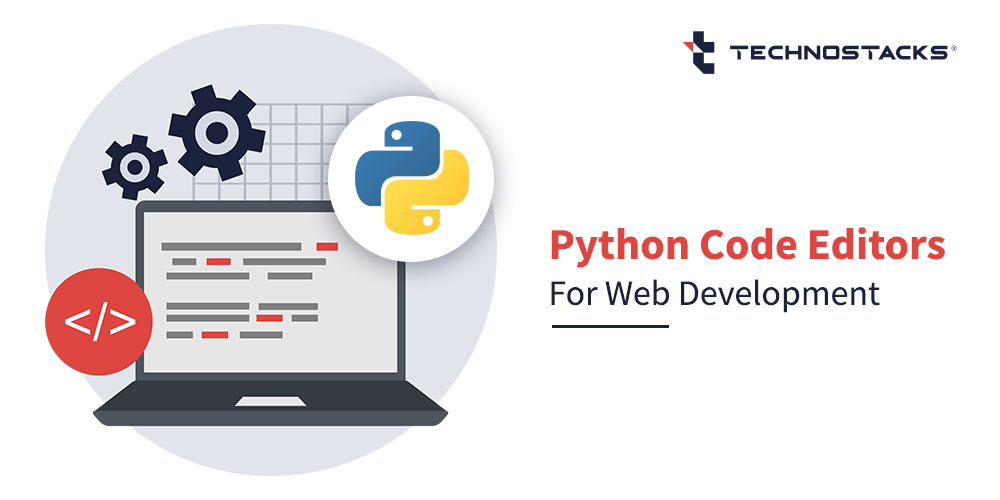The Complete Guide to Python IDEs and Code Editors
Writing Python code using the best python IDE ensures making the phase of coding fun. With the Python IDEs and Code Editors, you will get access to a myriad of choices. Broad categories of tools available include the ones built exclusively for Python development alongside the ones built for general development.
IDEs and Code Editors: The definition
An IDE (or Integrated Development Environment) serves as a program dedicated to software development. IDEs integrate several tools designed for software development, including An editor that handles code. In addition to that, it ensures Building, execution, and debugging tools. Also, the best Python IDE offers some form of source control.
IDE’s support different programming languages with a range of features. These tools, however, take time to download and install. Also, there is a need for advanced knowledge to use them properly.
A top python code editors execute code as well as control a debugger. These tools will also be beneficial for interacting with source control systems. The dedicated code editor is smaller and quicker.
A list of the best Python IDEs and Code Editors
- PyDev
IDE Eclipse + PyDev has the Python tools such as PyDev. This tool has become one of the most famous tools in the open-source community. Eclipse available for Linux, Windows, and OS X is the de-facto open-source IDE for Java.Extensions and add-ons make Eclipse useful for a wide range of development activities.PyDev, the online python IDE, enables Python debugging, code completion alongside enabling the interactive Python console. Installing PyDev into Eclipse is easy as you will have to follow some steps.Go to Eclipse, select Help >>> Eclipse Marketplace. After that, you will have to search for PyDev. Click Install >>> restart Eclipse. Eclipse installed is beneficial for adding PyDev, making the tasks quicker and easier. PyDev is accessible for the experienced Eclipse developer.
Key Features:
- The best IDE for python development is linear in size. PyDev concentrates on code-based refactoring, precise debugging in the designer patterns, alongside the study of code, thus working as the robust python transcriber. PyDev serves as a nice IDE with Django integration.
- In addition to that, the auto code completion and code coverage feature makes this one of the best tools.
- PyDev backs the PyLint amalgamation, tokens-based browser, Unittest incorporation, interactive console, and remote-based debugger. It enables syntax, high lighting, code folding, parser errors, and multi-language support is the overall essential unit.
- With a good outline view, PyDev marks occurrences and has an interactive console. Support for CPython, Iron Python, Jython, and Django makes this tool one of the best developers.
Pros:
- Supports Modeling
- Great for Larger Projects
Cons:
- Slow Performance
- Sublime Text
Python programmers with the need for a better text editor should invest in Sublime Text that serves as an extremely popular code editor.IDE to use for python is supportive on all platforms, making Sublime Text one of the best with built-in Python code editing. Also, there is an opportunity for setting a rich set of extensions (called packages) extending the syntax and editing features.Additional Python packages implementation turns out to be a bit hectic at times. All Sublime Text packages are written in Python, and installing community packages requires you to execute Python scripts directly in Sublime Text. The Sublime Text code editor supports a great following.Key Features:
- Sublime Text turns out to be highly beneficial and is fast, small, and well supported. Sublime Text ensures offering a huge range of benefits with the fact that it has the Discrete, minimal interface. That said, there will be scope to focus on the text and not toolbars.
- Customize it full screen, multi-screen, side-by-side with the file editing. When you have installed Sublime Text to make it work as the Python IDE, you will get the scope to utilize the different plugins and packages.
- That said, there will be an option for getting a high-quality and powerful IDE that allows development very easily. Also, it works with functionalities of an elementary Python text editor, comprising tailored syntax-based highlighting.
- Fast to use tools with very few bugs is one of the biggest advantages of using this tool. In addition to that, it Opens large files and supports many languages.
Pros:
- Refreshed UI theme
- New color schemes
Cons:
- Does not support autosave feature
- Atom
Atom is one of the best python code editors available on all platforms. “Hackable text editor for the 21st Century” comes out with a sleek interface, file system browser, as well as a marketplace for extensions.
Key Features:- It can be said that open-source Atom is built using Electron. Overall, python code editors for beginners serve as a framework for creating desktop applications.
- It works with the utilization of JavaScript, HTML, and CSS. Extension installed when Atom is running makes the Atom code editor stand out.
- Code Editor Atom offers broad support on all platforms, downloads, and loads fast.
Pros:
- Support a large number of programming languages
- Back a large number of packages
Cons:
- Slow Performance
- Vim
Linux, macOS and Windows-based Vim is the text editor allowing the manipulation of text files. Vim, one of the best python IDEs for professionals, first published in 1991 by Bram Moolenaar, has evolved and improved its developer. Also, Vim ensures the contribution of the developer community.
Key Features:- Vim is a bit different from the other python text editors in its modal mode of operation. Vim has three basic modes, namely, the insert mode, normal or commands mode, and command-line mode.
- Vim, the free software, is largely customizable by adding extensions. In addition to that, it ensures modifying its configuration file. That said, it ensures easily adapting it for development in Python.
- Many features include multi-buffers that support automatic indentation; simultaneous file editing adapted to the language.
- Feature-rich Vim provides a good user experience with community support.
Pros:
- Saves time
- Increase long term productivity
Cons:
- The nontrivial learning curve
- GNU/Emacs
Linux/macOS/Windows-based GNU/Emacs is the Text editor that had its Creation in 1976 by Richard Stallman, Emacs. Text editor with a set of features is very popular with the developer community.
Key Features:- A completely free and customizable editor without any restriction has many versions, including GNU Emacs.
- Powerful extension language Emacs Lisp has been the best for writing, compiling programs, surfing the Internet, and discussion forums.
- Free download best IDE for python in 2022 available on all platforms uses various customization scripts including Python.
- Use the Elpy extension on Emacs, and you will rest assured that the software is very feature-rich. Syntax to differentiate document elements makes the tool the best.
- Free and fully customizable GNU/Emacs ensure the automatic insertion of elements. The 24-bit color encoded support tool offers a range of advantages.
Pros:
- An extensible and customizable text editor
- Easy to extend the functionality
Cons:
- Tough learning curve
- Visual Studio
Microsoft has built Visual Studio as a best python IDE for web development comparable to Eclipse. Windows and Mac OS-based tool VS came available both free (Community) and paid (Professional and Enterprise) versions.
Key Features:- A variety of platforms alongside its marketplace for extensions makes python code editors for robust web development stand out.
- Also, there is the availability of the intelligence for Python, debugging, and other tools. When you already have Visual Studio installed for other development activities, ensure adding PTVS will be quicker and easier.
Pros:
- Free of charge
- Quick installation
- Lightweight installation package
Cons:
- It gets stuck at times
- Visual Studio Code
Visual Studio Code serves as a full-featured python IDE available for Linux, Mac OS X, as well as Windows platforms. What makes it favorable is that it is a small and light-weight, full-featured open-source, extensible, and configurable tool that ensures working the best with most tasks.
Key Features:- VS Code built on Electron has a small footprint and is open-source. Visual Studio Code is small but complete and will also be the best software that is open source under MIT license.
- There will be a scope to add a new language to the environment, such as Python, with this tool. Download and install the corresponding plugin for adapting to the environment.
- Well-designed open-source Python IDEs offers an extension-based architecture and is also boasting with more than 4700 extensions. Code management engine also makes this tool the best.
Pros:
- Free of charge
- Quick installation
- Multiple windows operating in a parallel process
Cons:
- Publishing code has many errors
- PyCharm
PyCharm is a best python IDE available in both paid (Professional) as well as free open-source (Community) editions. PyCharm ensures installation quickly and easily based on Windows, Mac OS X, and Linux platforms.
Key Features:- PyCharm is supportive of Python development directly. Open a new file and start writing code. Run and debug Python inside PyCharm, and is supportive for source control and projects.
- The Python IDE environment comes with tons of support. PyCharm, the Python development environment, ensures editing, running, and debugging Python out of the box. Features such as syntax highlighting, auto-completion, and live code verification offer advanced support.
- The paid version with advanced features such as full database management works better for the developers in many ways. Popular python IDE for windows in market is functioning as one of the most important Frameworks than the community version.
- Active community support with PyCharm guarantees advanced support. In addition to that, the tool Executes edits and debugs Python code without the necessity of involving in too many troubles.
Pros:
- Easy to use software
- Effortless Code debugging
- Synthesizes large projects
Cons:
- Steep learning curve
- Spyder
Spyder is an open-source Python IDE optimized for data science workflows. The Anaconda package manager distribution ensures offering advanced support. Data scientists using Python will get advanced support with it.
Key Features:- Spyder ensures integrating well with common Python data science libraries, including SciPy, NumPy, and Matplotlib. “Common IDE features” make code editor with robust syntax highlighting the best. In addition to that, Python code completion will work with the integrated documentation browser.
- “Variable explorer” allowing display of the data using a table-based layout ensures working well for fulfilling your necessities.
- Spyder feels basic compared to IDEs. Windows, macOS, and Linux support this tool and are fully open-source software. This is the most beneficial tool that is the best for the data scientist using the Anaconda Python distribution.
Pros:
- Free and open-source distribution
- Simplified package management and deployment
Cons:
- It consumes a longer time for loading
- IDLE
The integrated development and learning environment tool had its release in December 1998 by Guido Van Rossum. The best python ide IDLE is suitable for beginners and consists of a multi-window text editor.
Key Features:- Do developers ask What IDE is used for Python? In this regard, the tool IDLE is the best for syntax highlighting as well as an integrated debugger. The tool is the best for stepping, persistent breakpoints, alongside call stack visibility.
- IDLE can be used for the execution of a single statement. Also, the tool is the most favorable for the creation, modifying, and executing of Python scripts. IDLE offers features including syntax highlighting, auto-completion & smart indent.
Pros:
- Stepping & breakpoint features
- Built-in help
Cons:
- No integrated Debugging
- Thonny
Thonny is an ideal IDE that is the best for the platforms like Linux, macOS or Windows. It is also the platform where you will get access to the tool. The tool serves as an integrated development environment (IDE). The University of Tartu in Estonia has developed the software Thonny designed to make life easier for beginners. It serves as the simple, lightweight python IDE.
Key Features:- Excellent features make the Thonny like a beginner’s kit. Thonny turns out to be particularly suitable for beginners to start programming and development in Python.
- The tool Thonny is the best for development experts. Thonny comes with a better user interface isolated from all features. Programming Python Using an IDE is a great idea.
- Thonny turns out to be the well-planned pedagogical progression course for learners wishing to build projects directly in Python that too swiftly.
- IDE for beginners’ learning turns out to be the Basic and functional user interface and is the most suitable because it does not require a large amount of memory to run.
Pros:
- High-end Python-only editor
- Simple to install for Windows and the Mac
- Fast and safe refactoring
Cons:
- Multiple bugs
- Wing
Wing is the best tool that is supportive of WINDOWS, LINUX, MAC OS, etc. Wing, also a prevalent and commanding python IDE with several helpful functionalities, is the basic necessity for python-based project development.
Key Features:- A 30-day trial version also ensures that you will get a range of features. Wing ensures moving around the code with go-to-definition. In addition to that, it will be best for finding the uses and symbols in the application.
- Also, you can get the option to edit symbol index, source browser, as well as effective multiple-file search. It is also the best for test-driven development with unit test, pytest, as well as Django testing framework. Also, there is advanced support with remote development.
Pros:
- Intelligent Editor with Powerful Debugger
- Easy Code Navigation
Cons:
- Adding new packages is tricky
FAQs related to Python IDE:
Q1) What is referred to as Integrated Development Environment (IDE)?
Answer: IDE is the abbreviation for the integrated development environment. IDE works as a software package that consists of equipment used for developing and testing the software. In addition to that, it comes with editors, libraries, compiling, and testing platforms. IDE ensures automation of the task of a developer by reducing manual efforts while also combining all the equipment in a common framework. When IDE is not present, the developer manually does the selections, integrations, and deployment process.
It simplifies the SDLC process by reducing coding while also avoiding typing errors. Few of the programmers give more preference to Code-based editors, fundamentally working as text editors where a programmer needs to create the code for building any of the software solutions.
Q2) What is the meaning of IDE and Text or Code Editor?
Answer: IDEs for Python Programmers serves as a development environment providing many features like coding, executing, autocomplete, libraries, compiling, debugging in one place that ensures making tasks. On the other hand, a Code editor serves for editing and modifying the code only.
Q3) State the differences between IDE and TEXT EDITOR
Answer: IDE and Text Editor find use as a replacement for each other. Text editor ensures assisting the programmer in writing scripts, modifying code. When it comes to the use of an IDE, a programmer can perform several other functions. They ensure running and executing the code while also controlling the version. In addition to that, the tool ensures debugging, interpreting, auto linting function, compiling, and auto-complete feature. In addition to that, there will be predefined functions. IDE serves as a development environment with the opportunity for a programmer to write the script, compile and debug. With the integrated file management system and deployment tool support, IDE ensures working with the FTP, SFTP, SVN, CVS, and framework. The precise text editor serves and directs the involved source code and does not hold unified tools.
Q4) Why is there a need for the best Python IDE?
Answer: There are several advantages and gains of utilizing Python IDE, just like the advancement of higher quality programming and debugging functionalities. You will also get the features like compiling and deploying. That said, it turns out to be easier for the developer. Ideal IDE selection is based on the developer requirement. You will also get more extensibility and an integrated debugger.
Q5) How to choose the best Python IDE/code editor?
Answer: For beginners, it is worth considering the IDEs with basic features allowing discovery of the environment. For experienced developers, there is a need for the choice of your IDE based on the performance and advanced features of IDEs.
Key Takeaways
Each of these IDEs works with the integrated plugin system. Also, these IDEs and code editors are beneficial as they’ve got the configurable window layout, error highlighting, as well as advanced search functions making the tools quite supportive.
Advanced project management facility, version control, cooperation functions, integrated class browser, and source code ensure immense support.
In addition to that, they are loaded with features like cooperation functions, inbuilt task management, inbuilt debugger, profiling, and code coverage support, making these IDEs the best.









